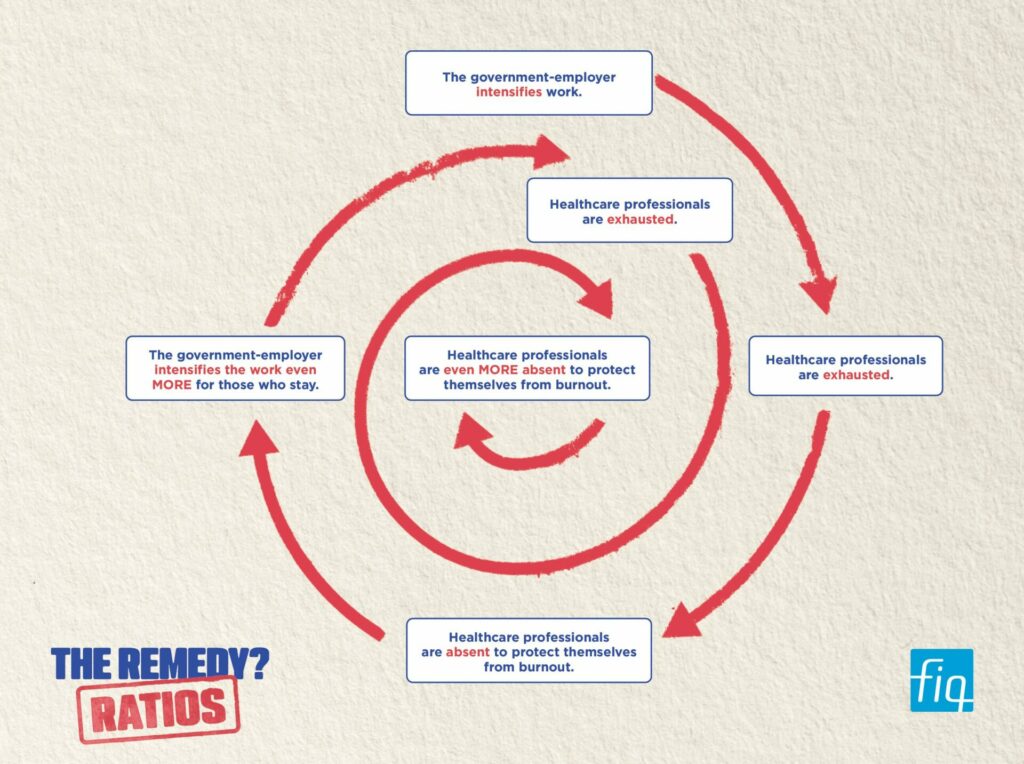Workforce shortage or shortage of attractive working conditions?
The government often points to a workforce shortage in the health network to explain care access problems and to justify the multiple reforms, but is this accurate? Is it actually a work crisis? The FIQ highlights five findings to look critically at the political decisions made by the government-employer. These decisions impact the health network and the attraction and retention of healthcare professionals.
*Paul-André Lapointe, Le lean management dans les hôpitaux : une rationalisation au détriment du soin, 2023, Ex Machina, (4), https://revues.uqac.ca/index.php/ad_machina/article/view/1510
Shortage
Workforce shortage

Observations
Healthcare professionals are confronted with difficult work and practice conditions. They find themselves in an insidious work crisis spiral caused by the government’s political choices (see image above).
In 2022, the total workforce in health and social services in the public and private sectors was 35% higher than in 1991, and this takes into account population growth and ageing.* Yet, the government at the time called the situation a workforce surplus.**
Today, the government is shirking its responsibility for the political choices it made that harmed the health network. It claims there is a workforce shortage when there is more staff than in 1991.
* Anne Plourde, Mythes et réalité de la pénurie de main-d’œuvre en santé et services sociaux au Québec, mai 2024, LaRISSS, IRIS, page 9.
** MSSS, Rapport du groupe de travail national sur les effectifs infirmiers, https://publications.msss.gouv.qc.ca/msss/fichiers/2022/22-945-03W.pdf, 2022, page 3.
The nurse workforce has increased by 8% since 1992, and this figure takes the population increase into account.* The president of the Ordre des infirmières et infirmiers du Québec (OIIQ), Luc Mathieu, was quoted in a Le Devoir article as saying the following: “We have never had so many in Québec. The number hasn’t stopped rising in the last 10 years.”** If we compare Québec to other Canadian provinces, the ratio of nurses per inhabitant is generally better in Québec. Recent OIIQ data shows that Québec has 7.74 nurses per 1,000 inhabitants, ranking better than Ontario, which has a 6.37/1,000 ratio.***
* Anne Plourde, Mythes et réalité de la pénurie de main-d’œuvre en santé et services sociaux au Québec, mai 2024, LaRISSS, IRIS, page 10.
** Le Devoir (Lia Lévesque, La Presse canadienne), https://www.ledevoir.com/societe/sante/771830/il-n-y-a-jamais-eu-autant-d-infirmieres-au-quebec, 22 novembre 2022.
*** OIIQ, Rapport statistique sur l’effectif infirmier et la relève infirmière du Québec 2022-2023, https://www.oiiq.org/documents/20147/26586017/oiiq-rapport-statistique-23-VF.pdf/6f710838-6645-eef2-90f6-152b5400d34a#:~:text=En%202022%2D2023%2C%202%20423,lutte%20contre%20la%20COVID%2D19, page 16.
When taking not only the increase but also the ageing of the population into account, we observe a decrease in the number of nurses compared to the 1990s. All things considered, Quebec faced the pandemic with 13% less nurses than in 1992. This situation has been made worse by the development of the private sector. In 1992, 85% of nurses worked in the public network whereas in 2022, only 72% did.*
More than a “labour shortage,” Quebec is experiencing an exodus of nurses to the private sector as a result of the government’s actions and policy choices.
*Anne Plourde, Mythes et réalité de la pénurie de main-d’œuvre en santé et services sociaux au Québec, mai 2024, LaRISSS, IRIS, page 10.
Considering the increase in the number of nurses per 1,000 inhabitants, where are the nurses missing from the public network?
- In the private sector because they earn a higher wage and because there is a more reasonable workload.
- Working part time to avoid burnout.
- On sick leave because of the toxic work climate and work overload.
The nurse shortage is caused by the work crisis. The FIQ has the same findings for all nursing and cardio-respiratory care professionals.
By hiding behind the supposed “labour shortage,” the government is looking to avoid accountability. We aren’t buying it!
It is possible to put an end to the work crisis healthcare professionals are going through. Healthcare professionals have several solutions: stabilize care teams, eliminate the work overload, ensure expertise is respected, etc. In short, work and practice conditions must be improved. It will require a massive investment in the public health and social services network.

